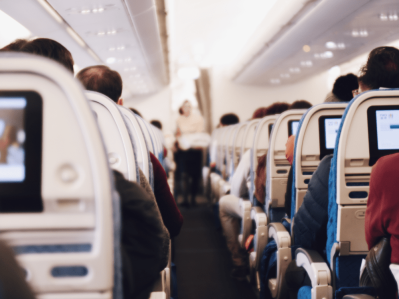Are Flight Attendants Allowed to Restrain Passengers?
Published At: Fri 20 Oct 2023

Air travel has become an integral part of our lives, connecting us to different parts of the world. However, it also brings with it a unique set of challenges and responsibilities for both passengers and crew members. One question that often arises is about the use of restraints on aircraft by flight attendants. Are they allowed to restrain passengers? If so, under what circumstances?
Understanding the Role of Flight Attendants
Flight attendants are primarily onboard for the safety and comfort of all passengers. Their duties extend far beyond serving meals and beverages; they are trained to handle various emergency situations, including unruly or disruptive passengers. But when it comes to restraining a passenger, there are specific guidelines that need to be followed.
The Use of Restraints on Aircraft: The Legal Perspective
The Tokyo Convention Act 1967 grants cabin crew members certain powers when dealing with disruptive passengers onboard an aircraft in flight. This includes the use of physical restraint if a passenger poses a threat to the safety of others or themselves.
However, this power is not absolute and must be exercised with discretion and proportionality. The use of restraints should only be considered as a last resort when all other means have been exhausted.
When Can Flight Attendants Use Restraints?
The decision to restrain a passenger is not taken lightly and is typically reserved for extreme situations where there's a clear threat to the safety or security of those onboard. Some instances where restraints might be used include:
1. Physical violence: If a passenger becomes physically violent towards others or themselves.
2. Threats: If a passenger makes serious threats that could jeopardise the safety or security of others.
3. Non-compliance: If a passenger repeatedly refuses to comply with instructions related to flight safety.
In such cases, flight attendants are trained in restraint techniques that minimise harm while ensuring safety.
The Procedure for Using Restraints
Before resorting to physical restraints, flight attendants will first attempt verbal de-escalation techniques and warnings. If these fail, they may then use physical restraint. Cabin crew must seek the approval from the Commander of the aircaft in order to use mechanical restraints such as plastic handcuffs.
Once restrained, the cabin crew must monitor the restrained individual regularly for signs of distress or discomfort due to restricted movement or breathing difficulties.
After landing, law enforcement officers usually take over from there, handling any necessary arrests or further actions required.
How Can SecuriCare Help?
At SecuriCare, we are world leaders in disruptive passenger behaviour prevention and management training. Since 1996, we have been dedicated to ensuring the safety and well-being of passengers and crew members during air travel. We provide comprehensive training programmes and innovative restraint systems trusted by thousands of cabin crew members worldwide, including some of the world's most prominent airlines. Our proven methods and skills have been successfully employed in numerous real-life situations, allowing cabin crew to intervene and manage disruptive behaviour effectively while prioritising the safety of everyone on board.
Cabin Crew Training:
Our training equips cabin crew with the knowledge and skills needed to handle disruptive passenger behaviour, ranging from mild incidents to potentially life-threatening situations.
Our comprehensive training covers the following key components:
-
National and International Legal Framework:
-
Understanding relevant laws and Air Navigation Orders in relation to Disruptive Passenger Management.
-
Crew's powers and obligations under these laws, ensuring compliance and safety.
-
Hierarchy of Threat Levels:
-
Identifying different threat levels and the corresponding appropriate responses.
-
Tailoring responses to the specific situation to maintain control and safety.
-
Police Protocols:
-
Collaborating with law enforcement when necessary, ensuring a seamless response to disruptive behaviour.
-
Early Intervention and Conflict Management:
-
Techniques for early intervention and conflict resolution.
-
De-escalation strategies to defuse tense situations and maintain a calm cabin environment.
-
Team Collaboration for Physically Challenging Behaviours:
-
Working as a cohesive team to manage physically challenging behaviours.
-
Coordinating efforts to ensure the safety of all passengers and crew.
-
Restraint of Violent Passengers:
-
Proper techniques for restraining violent passengers to prevent further physical threats.
-
Safely securing the disruptive passenger to an aircraft seat until authorities can take over.
-
SecuriCare Disruptive Passenger Restraint System:
-
Introduction to the innovative SecuriCare Airline Seat Restraint (ASR).
-
A safe and effective alternative to diverting the aircraft, preventing additional physical threats.
-
Post-Incident Management:
-
Procedures for handling disruptive incidents after they have been resolved.
-
Reporting, documentation, and debriefing to ensure continuous improvement and passenger safety.
SecuriCare Disruptive Passenger Restraint System:
Our groundbreaking SecuriCare Airline Seat Restraint (ASR) was developed and introduced in the 1990s. This system provides a secure and reliable means of containing and restraining violent passengers without the need to divert the aircraft. By safely securing a disruptive passenger to an aircraft seat, we prevent further physical threats and ensure the safety of everyone on board until the authorities can take over upon landing.
Conclusion
While no one wants their journey disrupted by unruly behaviour aboard an aircraft, it's comforting knowing that flight attendants are equipped with both training and legal backing in managing such situations effectively – including using restraints when necessary.
However, it's important for passengers too – we all have our part in maintaining peace aboard an aircraft by respecting fellow travellers' space and complying with instructions from cabin crew members for everyone's safety during flights.
SecuriCare's commitment to preventing and managing disruptive passenger behaviour ensures that cabin crew members are well-equipped to handle a wide range of situations, from minor disturbances to violent confrontations. Our training and innovative restraint systems empower crew members to protect the safety and well-being of passengers, fellow crew, and the aircraft itself, making air travel a safer experience for all.
